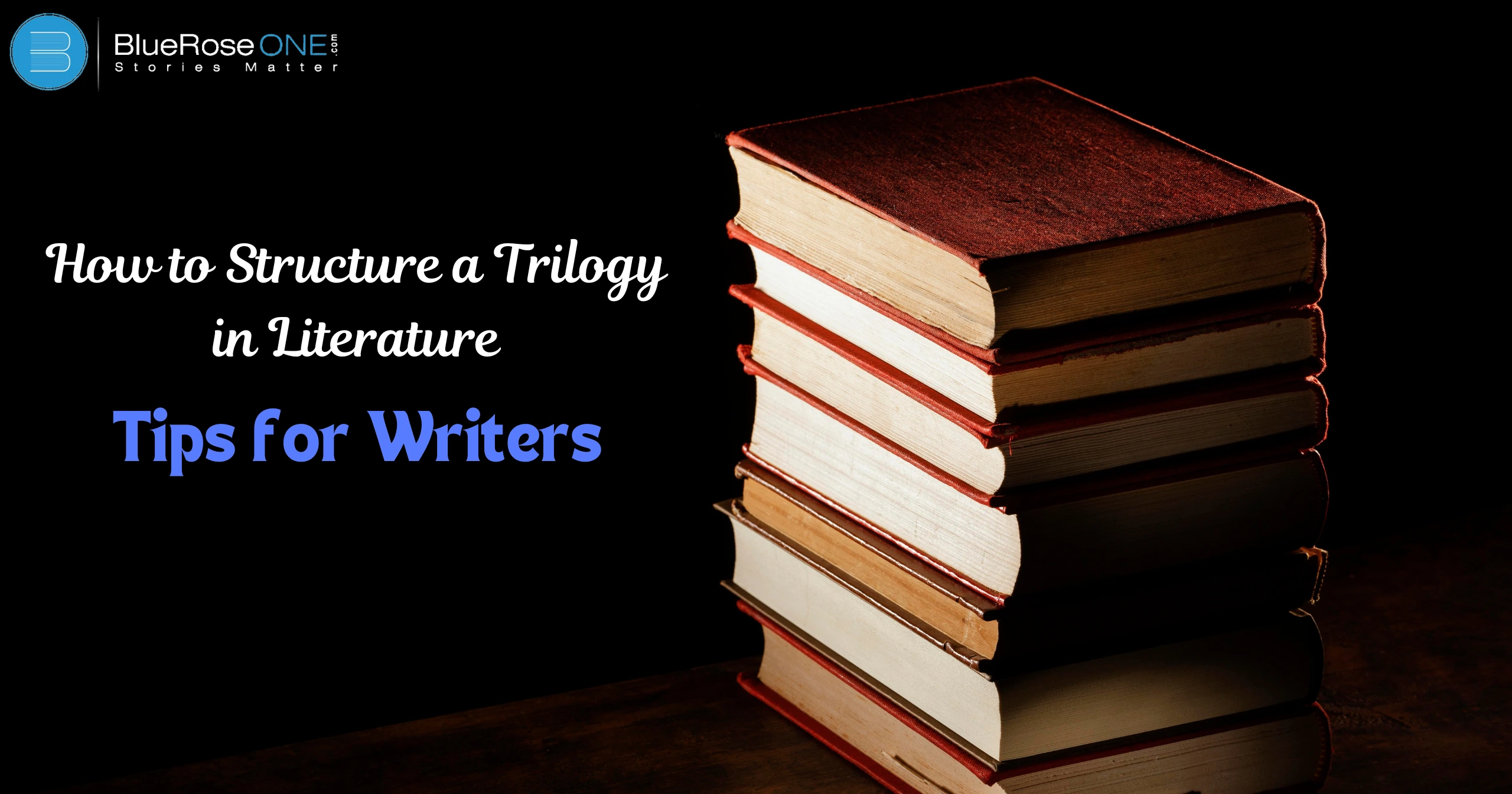It can be thrilling and intimidating to write a trilogy. If executed properly, it can develop into an engrossing, epic experience that draws readers in throughout several books. But a trilogy’s structure goes beyond just dividing a plot over three books. Planning, timing, and character development must be done with great care to guarantee that each book feels finished yet still adds to the overall story. Now let’s examine the key components of an effective trilogy’s structure.
What is a Trilogy?
A trilogy is made up of three related pieces, typically books, that together tell one continuous story. Though each book stands alone, taken as a whole, they tell a more comprehensive story. Popular genres for this format include science fiction, fantasy, and even historical fiction.
You may also like: Positive Character Traits And Why They Are Crucial
Why Are Trilogies So Popular in Literature?
Trilogies give authors the chance to explore a universe and characters in greater detail while providing readers with a longer read. When a fan falls in love with the setting or characters, a trilogy offers them additional time to delve further into the imaginary universe.
The Importance of Structure in a Trilogy
Why Structure Matters for a Trilogy
In a trilogy, structure is essential since it guarantees that each book develops organically and contributes to the overall plot. Each book in a well-structured trilogy advances the plot and character development while maintaining a distinct beginning, middle, and end for all three volumes.
A trilogy that lacks coherence runs the risk of seeming disconnected or unfinished. A satisfactory climax to the entire series is achieved by careful planning, which also serves to maintain narrative tension and keep readers interested.
Differences Between Single Books and Trilogies
The way the plot develops in single books and trilogies is one of their main distinctions. The plot arc of a single book must be finished in just one volume, whereas a trilogy permits longer storytelling.
A trilogy’s books usually have a three-act structure: the first establishes the story, the second intensifies the conflicts, and the third and final book settles them.
Authors have greater space to create intricate plotlines and well-rounded characters in several chapters because to this expanded structure.
You may also link: Foreword vs. Preface: Know the Difference
The Three-Act Structure Applied to Trilogies
Using the traditional Three-Act Structure, in which each book corresponds to a separate act, is one of the best methods to organize a trilogy. Let’s dissect it:
Act 1: The Beginning (Book 1)
Establishing the World and Characters
Setting up the universe and the characters is essential in the first book of a trilogy. Readers are now familiar with the protagonist, the environment, and the main conflicts that will propel the narrative.
Enough detail should be included in the world-building to captivate readers without being overbearing. In order to keep readers interested in the characters from the beginning, character development should also allude to deeper levels that will be revealed during the trilogy.
Introducing the Core Conflict
A trilogy must begin with the introduction of the central conflict that will run through the whole book. This conflict, which could be a struggle for power, survival, or something more personal, usually creates the stakes and sends the protagonist on their journey. Act 1 establishes the framework for the primary issue, which foreshadows character growth and subsequent narrative turns throughout the trilogy.
You may also like: Vellum Review: Definition, Features and Pricing
Act 2: The Middle (Book 2)
Deepening the Conflict
A trilogy’s “The Middle” or Book 2 is the second act, where the fight intensifies and forces the characters to overcome more difficult situations. At this point, the stakes get higher as the characters either significantly advance or suffer setbacks.
A lot of the time, book two ends on a cliffhanger, leaving questions unanswered to heighten the tension in the last act. Authors keep readers interested and invested in the Trilogy’s conclusion by intensifying the conflict.
Developing Character Arcs
In a trilogy, character arc development and suspense building are frequently the main goals of the second novel. Characters must overcome more obstacles in this scene in order to change.
Since they must resolve internal conflicts and make decisions that may affect the ending, this act is essential to the growth of the characters.
Characters ought to be at their lowest by the end of the middle book, laying the groundwork for the third book’s resolution. Trilogies have a tension that keeps readers interested until the very end.
The Climax of Book 2
Book 2 is important in a trilogy since it is Act 2 of the three acts. Often referred to as the “rising action,” this middle portion builds character development and deeper conflicts, laying the groundwork for the book’s finale.
A major turning point or encounter that raises the stakes and presents the protagonist with fresh obstacles usually occurs in the conclusion of Book 2.
This crucial point guarantees that readers will stay interested and involved in the resolution that will occur in Book 3, advancing the story toward a satisfactory finish.
You may also like: 10 Proven Startegies for Crafting the Perfect Book Title
Act 3: The End (Book 3)
Resolving the Conflict
The story finds its climax and resolution in “Resolving the Conflict,” the last act of a trilogy. This is the point at which every storyline strand is resolved to tackle the main conflict that was first presented in previous volumes.
As characters face their greatest obstacles, their outcomes are predetermined. This resolution should feel both unexpected and inevitable, providing readers with a sense of closure, for the trilogy to be successful. Writers make sure their trilogy is remembered by closing up loose ends and offering a satisfying finale.
Delivering a Satisfying Conclusion
In a trilogy, bringing the story’s arc to a satisfactory close in Act 3, or the last book, is essential. Major conflicts should be resolved, unanswered concerns should be addressed, and the characters’ journeys should come to a satisfying conclusion at the end.
In order to make the reader feel emotionally and fully pleased, this ending should weave together important themes and plotlines from the earlier books. Creating a compelling trilogy finale not only completes the story but also leaves the audience with strong feelings.
You may also read: 7 Types of Conflict in Literature
Creating a Unified Theme Across the Trilogy
How to Keep a Consistent Theme
Establishing the main point or concept that you wish to address in each of the three novels can help you to maintain a unifying theme across your trilogy.
Make sure that every episode advances the plot, develops the characters, or changes the setting in order to contribute to this subject. Check that each book’s draft is in line with the concept on a regular basis and make any adjustments.
This strategy will contribute to the development of a unified plot that runs the course of the trilogy, increasing the overall impact and engagement of the narrative.
Avoiding Disjointed Narratives
In order to keep a trilogy’s plot coherent, fragmented tales must be avoided. Every book should add to the overall plot so that all character arcs and stories flow together naturally.
Start by providing a synopsis of the complete trilogy in order to pinpoint recurring themes and story points. This method keeps each installment from feeling disconnected or irrelevant and aids in the development of a cohesive theme. A well-organized trilogy maintains readers’ interest and commitment to the plot’s development.
You may also like: 10 Proven Strategies for Crafting the Perfect Book Title
Developing Character Arcs Over Three Books
Character Growth Across Books
Character development is crucial in a trilogy to maintain reader interest. A character should change dramatically over the course of three books, overcoming obstacles that further their growth.
While the second book intensifies the character’s challenges and forces them to face their faults, the first book frequently highlights the character’s flaws and objectives.
The character ought to have a conclusion by the third book, demonstrating evident development and transformation. This development contributes to the trilogy’s rewarding narrative arc.
How to Balance Multiple Character Arcs
In a trilogy, juggling many character arcs calls for meticulous preparation and consistency. Start by outlining the journeys of each character and how they relate to the trilogy’s broader story.
Make sure these arcs are progressed in every book, with every episode offering development and evolution. Determine your personal objectives and conflicts in the first book.
These storylines ought to be developed further in the second book by including more challenges and character interactions. The last book should satisfactorily wrap up the storylines, connecting the character growth to the overarching plot of the trilogy.
You may also read: 7 Elements of a Story: Structure and Significance
Pacing in a Trilogy
Balancing the Pacing of Each Book
Maintaining reader involvement in a trilogy requires careful consideration of how each book in the series flows. Every book should have a distinct rhythm; the first should introduce the reader to the universe and characters, the second should intensify the tensions, and the third should offer a satisfying conclusion.
Making sure the pace increases gradually without tiring out the reader is crucial. A trilogy’s effective pacing requires careful planning to maintain the story’s coherence and excitement over all three volumes, making for an enjoyable read.
Avoiding “Middle Book Syndrome”
In a trilogy, avoiding “Middle Book Syndrome” is essential to keeping readers interested. When the second book lacks momentum or seems like a filler, this common problem arises.
Make sure every book in your trilogy has a unique arc that contributes to the overarching plot to counteract this. Make the most of character development and story advancement to ensure that the middle book does more than merely act as a transitional piece. You can keep readers interested from beginning to end by striking a balance between pacing and story growth.
You may also like: Top 10 Tony Robbins Books That Inspire Success and Change
Subplots in a Trilogy
How to Create Engaging Subplots That Span All Three Books
Make sure each subplot supports the main plot and develops over time in order to construct captivating subplots that span all three volumes of a trilogy. Early in the first book, introduce the subplot and let it grow with each new chapter.
Incorporate significant character development or concepts into the subplot to keep it connected to the main arc. In addition, settle small disputes from previous novels while leaving enough unanswered to keep readers interested as the trilogy progresses.
Tying Up Subplots in the Final Book
A trilogy’s last volume must tie up loose ends for readers to feel satisfied with the resolution. Subplots should support the main plot as the trilogy develops, providing depth and increasing suspense.
All the unfinished business must be finished in the last volume. This guarantees that every character development and side tale advances the main idea of the trilogy. The series seems finished and leaves readers with no unresolved questions thanks to careful planning.
How to Fix Common Trilogy Structure Problems
Pacing Issues: A trilogy’s pacing can frequently be problematic. It happens frequently that the first book starts out well, the middle books drags, and the last book closes quickly.
Make sure every book has a distinct storyline with increasing suspense and stakes to address this. Refrain from overly extending subplots or adding too many new components. Maintaining reader attention and producing a more unified trilogy can be achieved by maintaining a consistent pace across all three books.
Disjointed Plotlines: Disjointed plotlines, in which the tale feels uneven or fragmented between the novels, are a typical problem in trilogies. Make sure the three books in the trilogy each have a distinct, overarching plot to address this.
Create a strong outline that connects the key moments and progresses toward a satisfying ending. The basic plot of the trilogy should be furthered by each book, with characters, themes, and conflicts remaining consistent to prevent abrupt changes in the narrative’s flow.
Conclusion
Writing a well-organized trilogy can be very fulfilling for authors as well as readers. You may write a trilogy that captivates readers from the first to the last page by meticulously organizing your plot, giving characters growth throughout the story, and sticking to your major theme. Always keep in mind that each book should seem finished on its own and contribute to the overall story line.
















